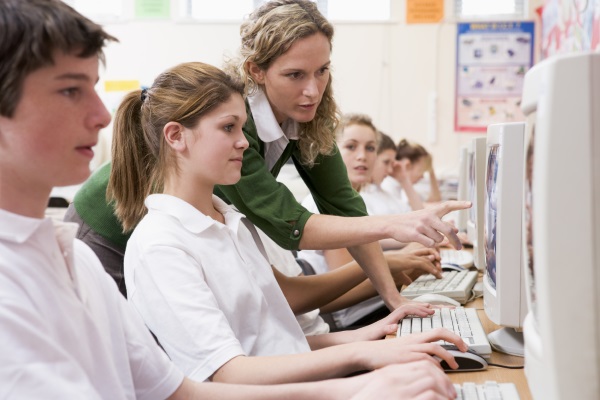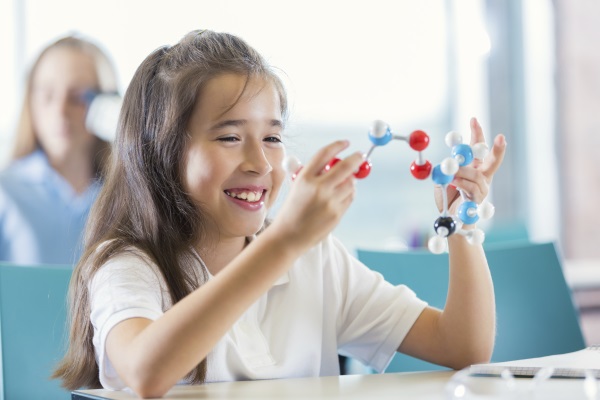How can teachers ensure that able children are excited by science and appropriately challenged in ways that are motivating and rewarding?

Our gifted and talented pupils are the sort who read a lot and avidly watch all the science programmes on TV.
If you can't find something to inspire these children, they will soon get bored.
It's our job to make sure they have a wide range of materials in varied formats so they see the relevance and the excitement of science.
We use a combination of test scores and levels of interest to identify gifted and talented children.
In Year 7, we look at pupils who have been highlighted by their primary school, acknowledging that there will be others who still have to discover their aptitude for this subject.
We encourage more scientific thinking and a passion for accuracy, even in pupils who are not necessarily gifted. Our science club provides opportunities to explore different areas and maintain their enthusiasm.
In a big school such as ours, it's important to regularly reassess so that no child is overlooked.
Developing more able learners in a short space of time isn't an easy feat, but neither is it impossible.
Download our two-hour time plan to tackle your responsibilities in no time.
We want pupils to achieve the highest level of science skills, and to this end we have to keep them motivated by the subject.
Technology has a lot to offer in this respect, providing access to banks of interactive, multimedia materials which offer enormous potential for individualised learning and differentiation.
Our library has 20 work stations; we have 5 computers in every lab which pupils can use at any time.
With a printer card, any pupil can access printers in the corridor to print out their work. We also assign homework tasks so they have sufficient time to complete work.
We use assessment materials from Badger which cover levels 3-5 and 5-7, so learners can establish exactly what they need to do.
The assessment tasks can be quite creative: for example, 'Explain the journey of a cheese sandwich through your digestive system either by writing a story or drawing a cartoon.'
Good software is useful in ensuring that able pupils learn the basics, even when they are impatient to understand on a deeper level and find answers to complex questions.
Sometimes they are asking A-Level questions when they are only in Year 8 and we need to offer resources which can bridge the gap and give high level answers in a form which they can understand.

Good software offers opportunities for pupils to explore and describe things in a scientific way.
We use second-generation software (e.g. Sunflower) to demonstrate models of different science situations.
Sometimes, seeing science in action raises more questions from the brighter pupils as they start to go deeper and want to know more
For example, when children are learning about fission, fusion and fission chain reaction, they can see on screen exactly what happens at nucleus level.
Similarly, we might show models of enzymes. Once we raise the temperature the enzymes change shape so food no longer 'fits'.
Pupils can see the whole process in under two minutes and can watch it as many times as they want. Sometimes, seeing science in action raises more questions from the brighter pupils as they start to go deeper and want to know more. It also helps with misconceptions.
Some learners know that raising the temperature will change the enzymes. When they see the model they realise that it's a gradual ongoing process, and not a total destruction that happens as soon as the environment gets hotter!
DNA is another area which is notoriously difficult to teach. Pupils can understand much more easily when shown animations and simulations of DNA structure and uses. They can see the coils of DNA in the nucleus and watch as the two strands separate, the nucleotides join each strand and then the strands coil back up.
Sometimes we combine simulations and hands-on work. For example if we use an onscreen simulation for circuits, all the bulbs and batteries work and pupils can experiment with variables. If they blow a bulb they can just drag in another.
On the other hand, first-hand experience of actually making a circuit and seeing it work is rewarding and exciting and an essential part of the learning.
I have been teaching for many years, and in the past I used to do wonderful illustrations in chalk on a roller board. This method worked quite well, but it was dependent on the artistic skills of the teacher and some children found it hard to read the labelling from the back of the room.
Online simulations are a quicker way of showing what happens. It frees up more time for teaching instead of demonstrating.

Pupils can understand much more easily when shown animations and simulations of DNA structure and uses.
We have two science clubs: a general one which most of the pupils can join, and a CREST awards club which starts in Year 8. This is a project-based awards scheme for the STEM subjects for children between 11-19.
Activities tend to be open-ended and more challenging, so pupils can get involved in serious in-depth investigations.
We make good use of resources provided by the Association for Science Education. Pupils might find themselves testing David Beckham's fitness considering areas such as blood pressure, urine, cholesterol, blood group and vital lung capacity, and have to choose the 10 most important tests. They are applying their knowledge in real life situations.
We need to make sure that the children see science as something which relates to the world around them
Studying digestion is made interesting and fun by creating a day's 'bugs and rice' diet for 'I'm a Celebrity Get Me Out of Here'.
Armed with a nutrition chart, pupils have to deliver a menu which will provide 80g of protein, 300 g of carbohydrate and 40g of fat and compare the delights of water beetles and honey-pot ants. It's disgusting, but the children love it, and it provides good opportunities for differentiation by outcomes.
We need to make sure that the children see science as something which relates to the world around them.
We hope that many of our brightest pupils will go on to careers in science and technology. Our young people are working towards jobs which do not exist as yet.
It may well be that our young people are working towards jobs which do not exist as yet
We need to make sure they develop the essential scientific skills, such as curiosity, objectivity and perseverance.
Like many schools we invite STEM ambassadors into school to give careers talks or get involved in clubs, school events, lessons and competitions.
We work with a technology company, 3M, whose head office is close by. 3M has created a primary online teaching resource, 3M Streetwise, that helps children to look at the scientific principles underpinning road safety rules: light, sound and forces. It has interactive tasks, an animated film and a game which lets pupils check their level of understanding.
For secondary pupils there is 3M Worldlywise, which focuses on sustainability and the environment. The site is set in a fictional town which pupils travel around. They come across different aspects of sustainable living and see how scientists and engineers can help solve the problems of the future.
We try to blend good materials with challenging activities and real life applications to bring science to life
Recently, the ground floor of 3M Centre was opened up as an exhibition centre for two weeks and a day was set aside for schools, taking in 120 pupils from Garth Hill and neighbouring Brakenhale School.
The area was transformed into a series of stage sets representing locations such as a building site, an operating theatre, a car body shop, a data centre, a metalwork factory and a police station.
The children saw protective screens for computer equipment, finger-print readers, reflective materials for police cars and passport scanning equipment.
Of particular interest were ear protectors which blocked noise in a factory but allowed people to hear one another speak, and a protective film for mobile phone screens with in-built technology that gets round the problem of air bubbles.
One of the Y9 girls who went to 3M said, 'Science is one of my favourite subjects, and I’ve enjoyed seeing it in action at 3M. The film that protects cars from scratches is very clever and I think this would be a good solution for our car to protect the paintwork. I also enjoyed seeing the reflective traffic materials in the dark.'
It is important that gifted and talented are stretched. We try to blend good materials with challenging activities and real life applications to bring science to life.
The days are long gone when a bright child would sit at the back of the class just doing more of the same and bored to tears.
We now have much more active and engaged learners.